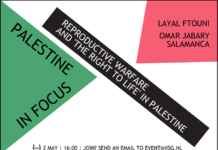Alex Kane
Jewish Currents / June 13, 2023
By granting Israeli citizens legal access to a disbanded Jewish settlement in the West Bank, the government has fulfilled one of the Jewish settler movement’s central demands.
On May 18th, the Israel Defense Forces (IDF) reversed its ban on Israeli citizens entering Homesh, a Jewish settlement in the northern West Bank that has legally been off-limits to Israelis for nearly two decades. The army’s move, which gave force to a March 21st Knesset decision permitting Israelis to access Homesh, represents a major victory for the Jewish settler movement.
The goal of returning to Homesh has been in settlers’ sights since 2005. That year, then-Prime Minister Ariel Sharon adopted a policy known as “disengagement,” under which Israeli soldiers evacuated settlers from Gaza as well as four small, isolated northern West Bank settlements. After the evacuation, soldiers demolished settlers’ homes, and in some cases, other structures such as settlement yeshivas. For Sharon, disengagement was a way to bolster Israeli security and initiate a process of unilateral separation from Palestinians, but for the Israeli settler movement, it was a profound defeat: a blow to their territorial aspirations of bringing Gaza and all of the West Bank under permanent Israeli control. According to Avishay Ben Sasson-Gordis, a research fellow at progressive Jerusalem-based think tank Molad, many settlers felt that they had been betrayed. “There’s a generation of settlers and religious Zionists scarred by the sense that the state turned on them,” Ben Sasson-Gordis said.
Settlers have long demanded a complete reversal of disengagement. Though support for the idea was once limited to the fringes of Israeli politics, the former fringes are now in power, as evident in the Knesset and IDF’s partial reversal of disengagement in Homesh. Settlers have welcomed the change. “This is a historic moment, a step toward rectifying the terrible injustice of the expulsion from Samaria,” declared Yossi Dagan, the head of the Samaria Regional Council, the body that provides municipal services to northern West Bank settlements.
Homesh was established as a military base in 1978, on lands that had been seized from Palestinians from the village of Burqa. In 1980, the military handed the area over to settlers, who began building homes there. Initially, most of the residents of Homesh were secular Jews, but the composition of the settler population began to change in the early 2000s. After a series of Palestinian attacks killed several residents, secular families began to leave Homesh, triggering settler anxiety about “a mass stampede from all the West Bank’s Jewish communities,” according to a 2005 Haaretz article. To ensure Homesh would not be abandoned, religious Zionists began to move into the settlement.
Soon after it became an outpost of religious Zionists, however, Homesh was evacuated. In 2005, the Knesset approved Sharon’s disengagement plan, prompting the removal of over 8,000 Jewish settlers from Gaza and 500 from the northern West Bank settlements of Sa-Nur, Ganim, Kadim, and Homesh. The new law also barred Israelis from re-entering the evacuated areas. On the first day of the evacuation from Gaza, Sharon gave a speech explaining the reasoning behind the disengagement: “More than a million Palestinians live [in Gaza] and double their number with each generation.” Under these circumstances, Sharon believed that it was demographically advantageous to withdraw from an area that endangered the concept of the country’s Jewish majority. (While Sharon removed settlers and soldiers from the interior of Gaza, Israel has continued to control Gaza’s airspace and waters, and in 2007 imposed a blockade that severely limits Gazans’ freedom of movement and their ability to import and export goods.) Security was another factor motivating Sharon’s decision: Palestinian militant groups in Gaza often attacked Jewish settlements there, and the four isolated West Bank settlements were also easy targets for Palestinian gunmen.
Finally, Israel used the disengagement to assure the US and the international community that it was committed to withdrawing from Palestinian land—a necessary precursor to the establishment of a Palestinian state, the presumed end goal of the Oslo peace process. Daniel Kurtzer, who was the US ambassador to Israel at the time of disengagement, told Jewish Currents that Sharon’s withdrawal from Homesh and other West Bank settlements was particularly important evidence that Israel would not limit its territorial concessions to Gaza. “In the discussions we had, Sharon agreed that, to prove that this was not a Gaza-only action, he would remove some settlements from the West Bank,” Kurtzer said.
Settlers saw the resulting disengagement as “the thin edge of a wedge that will eventually lever Israel out of the West Bank and parts of Jerusalem as well,” according to a 2005 Economist dispatch. The settler movement set about trying to undo the disengagement, and Homesh became a focal point of that struggle. Ahmed Abofoul, a legal research and advocacy officer at Palestinian human rights organization Al-Haq, told Jewish Currents that because Homesh is “located in the middle of the road linking the governorates of Jenin, Tulkarem, and Nablus,” reoccupying it would “serve the purpose of further facilitating Israel’s strategic fragmentation of the Palestinian people.” In other words, the resettlement of Homesh would constitute an important step toward making a contiguous Palestinian state impossible.
Over the past 15 years, Jewish settlers have made incremental progress toward this goal. The Israeli army’s control over the West Bank has made it possible for settlers to illegally access the area, and over the years they have held rallies and camped on the sites of their former homes. By 2007, settlers had established a makeshift yeshiva on private Palestinian land. Though the army has sometimes demolished such illegal structures—for instance, soldiers razed part of a road and several yeshiva buildings in 2021—it has by and large continued to allow settlers a foothold in the area.
Jewish settlers’ continued presence, and the army’s complicity in it, has prevented Palestinians from accessing Homesh. In 2011, Palestinians from the village of Burqa filed a lawsuit in Israel’s High Court of Justice demanding that they be able to return to their lands, causing the Israeli army to revoke its 1978 order seizing the area. But according to a report by Israeli human rights group Yesh Din, “while there is no longer any legal impediment, Palestinians still cannot reach their private land and farm it because Jewish settlers are constantly present there, in violation of the law.” In 2019, Yesh Din helped Palestinians from Burqa to file another petition with the Israeli High Court. During a May 2022 hearing on the petition, the Israeli government said that Homesh must be evacuated, but did not specify when. All the while, Israeli settlers have used Homesh as a base from which to physically attack Palestinian residents in surrounding villages. According to Abofoul, Homesh’s “close proximity to [Palestinian] civilians creates a coercive environment” that is designed to push them out. “It’s quite challenging to live next to extreme Israeli [Jewish] settlers,” Abofoul said. Yesh Din has referred to this as a settler campaign to “terrorize the Palestinians, take over their land and forcefully expand the area subject to the settlers’ control.”
When the most right-wing government in Israel’s history came to power in December 2022, the settler movement came even closer to its longstanding goal of undoing disengagement. Netanyahu chose Bezalal Smotrich, the head of the Religious Zionist party, as his finance minister, and also put him in charge of overseeing Jewish settlements as a junior minister in the defense ministry. Smotrich has long been a staunch opponent of the disengagement: In 2005, he was arrested by Israel’s intelligence authorities on suspicion of planning a terrorist attack in protest of the law, aimed at disrupting traffic on a main thoroughfare. In exchange for backing Netanyahu’s premiership in 2022, Smotrich secured a promise that the new government would work to reverse the parts of the disengagement that barred Israelis from re-entering the West Bank settlements they had left in 2005. In March 2023, the Knesset followed through on Netanyahu’s promise, passing a law that lifted the ban. “The settlers and their supporters are in positions of power, and they can strike and score when opportunities are presented,” said Yehuda Shaul, the co-director of Ofek, an Israeli think tank dedicated to advancing a two-state solution.
This partial reversal of the 2005 disengagement has garnered international criticism. The Biden administration has opposed the move, which the State Department called “provocative and counterproductive.” During a March 21st press briefing, State Department spokesperson Vedant Patel said that “advancing settlements is an obstacle to peace and the achievement of a two-state solution,” adding that the Knesset vote violated Sharon’s commitments to the Bush administration. For the first time during Biden’s presidency, the administration summoned Israel’s ambassador to a meeting with Deputy Secretary of State Wendy Sherman to protest the Knesset’s decision, a diplomatic admonishment considered more serious than a statement of opposition. But the Israeli government has not changed course, in large part due to the electoral power of the settler right. “Smotrich is more of a threat to Netanyahu than Biden is,” Hagit Ofran, the head of the Israeli group Peace Now’s Settlement Watch project, told Jewish Currents.
While Israeli officials reportedly told the Biden administration that Israel would not permit the construction of a new settlement in Homesh, the Israeli government is seemingly intent on making a Jewish presence there permanent. On May 29th, Jewish settlers moved the Jewish religious school in Homesh from private Palestinian land to “state land”—land in the occupied West Bank that the Israeli army has seized. The yeshiva’s previous location was illegal not only under international law (as all settlements are, according to the United Nations) but also under Israeli law, which prohibits the building of unauthorized settlements on private Palestinian property. But after its recent move, the yeshiva is now considered legal by Israeli authorities.
Ofran says the legalization of the yeshiva marks the beginning of a newly authorized settlement in Homesh because Israelis live and sleep on the premises. Peace Now has warned that any roads to and from the yeshiva will occupy private Palestinian land, further entrenching the settlement. Journalist Amira Hass has similarly noted that the yeshiva may be only a first step: Settlers could begin building new homes next.
Meanwhile, the Jewish settler movement is continuing its efforts to regain other lost settlements. On May 22nd, the day after the military lifted the ban on Israeli entry into Homesh, Knesset member and settlement activist Limor Son Har Melech said she was not satisfied with the win. “We passed a law that relates to the four settlements in northern Samaria—Homesh, Sa-Nur, Kadim, and Gadim—from where we were expelled,” she told The Times of Israel. “The next stage we are talking about is to build and return to those settlements.” Shaul, of the Ofek Center, takes settler activists at their word that Homesh is only the beginning. “The next thing will be Kadim and Ganim, and then returning to Gaza—which is not a program to be implemented tomorrow, but is a very live idea,” he said. “The second you give political extremists a victory, the second you give in to one demand, their political imagination travels very far.”
Alex Kane is a senior reporter for Jewish Currents












